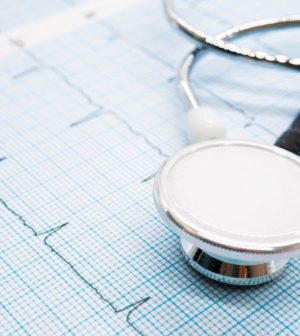- Navigating Your Midlife Crisis: Embracing New Possibilities
- City Raccoons Showing Signs of Domestication
- Mapping the Exposome: Science Broadens Focus to Environmental Disease Triggers
- One Week Less on Social Media Linked to Better Mental Health
- Your Brain Changes in Stages as You Age, Study Finds
- Some Suicide Victims Show No Typical Warning Signs, Study Finds
- ByHeart Formula Faces Lawsuits After Babies Sickened With Botulism
- Switch to Vegan Diet Could Cut Your Greenhouse Gas Emissions in Half
- Regular Bedtime Does Wonders for Blood Pressure
- Dining Alone Could Mean Worse Nutrition for Seniors
Wearable Heart Monitor Ups Detection of A-fib by More Than 50%

A wearable heart monitor raises the detection rate of the dangerous irregular heartbeat known as atrial fibrillation (A-fib) by more than 50%, a new study finds.
Unfortunately, there was no increase observed in the number of strokes prevented after folks got the devices, the researchers noted. A-fib can create clots that can then trigger strokes.
It was hoped that, with A-fib spotted earlier in more people, patients might be prescribed anti-clotting meds that could bring stroke rates down.
However, “we still need definitive evidence that diagnosis of atrial fibrillation through systematic screening can lead to subsequent treatment with oral anticoagulation and therefore, lower stroke risk,” said study lead author Dr. Renato Lopes. He’s a professor of medicine and member of the Duke Clinical Research Institute in Durham, N.C.
Lopes’ team presented its findings Sunday in London at the annual meeting of the European Society of Cardiology. The study was also published simultaneously in the Journal of the American College of Cardiology.
During A-fib, “the heart’s upper chambers — called the atria — beat chaotically and irregularly. They beat out of sync with the lower heart chambers, called the ventricles,” according to the Mayo Clinic.
The arrhythmia can have no symptoms but should be treated — usually with medicines or a procedure called ablation — to reduce a person’s odds for stroke.
Spotting the condition is crucial. The new trial was funded by drug makers Bristol-Myers Squibb and Pfizer, and included more than 12,000 Americans age 70 or older who all had no diagnosed history of A-fib.
They were assigned to either “usual care” or to wearing a continuous heart monitoring device for a period of two weeks.
Over the next 15 months of follow-up, researchers reported a 52% rise among the monitor-wearing group in the number of people whose A-fib had been detected.
However, trial enrollment had to be stopped at about 12,500 people because of the onset of the pandemic.
The trial was originally slated to comprise more than 52,000 people, Lopes’ team noted, and it’s possible that had those numbers been reached they could have drawn a conclusion as to whether better detection of A-fib led to more timely treatment and a reduction in stroke risk.
“Despite the inconclusive results, we have a lot of lessons learned that might inform future studies,” Lopes said in a Duke news release. He is hopeful the study’s methodology can be used again in future trials.
More information
Find out more about atrial fibrillation at Johns Hopkins Medicine.
SOURCE: Duke University, news release, Sept. 1, 2024
Source: HealthDay
Copyright © 2025 HealthDay. All rights reserved.










